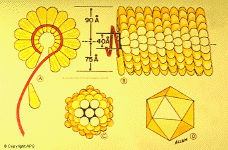
Activity
1 - Student Learning Strategies:
TESTING PHIX174 HOST RANGE

(Image from Virology.net, The Big Picture Book of Viruses, 2002)
PURPOSE
The first step in a successful viral infection is the attachment of the virus
to its host cell. This can only take place when the virus and the host cell
are compatible. Some viruses can only infect one particular host, while others
can infect a number of different host species (the collection of susceptible
host species is known as the host range of the virus). Compatibility hinges
on whether or not the virus can bind to any of the host cell receptor molecules
on the outside of the cell. These receptor molecules of course do not exist
for the convenience of the virus. Rather, the virus has found a way to take
advantage of cellular receptors that pre-exist for other reasons. We in turn
can take advantage of viral specificity to begin to identify the virus. For
bacteriophages such as Phi X 174, we can use a so-called plaque assay to test
for host range. This assay is based on the ability of some viruses to lyse,
or destroy the host cell. In the lab, a dilute solution of the bacteriophage
is mixed with a dense bacterial culture and plated on a petri dish. Fed by the
nutrients in the petri dish, the bacteria multiply to cover the entire dish,
forming a visible bacterial lawn. Wherever a viral particle is present, if the
virus and host are compatible, the virus particle will infect one of the bacterial
cells. Viral replication followed by host cell lysis spews out many more infectious
viral particles, each of which can go on to infect a neighboring cell. When
enough neighboring host cells have been lysed, a characteristic clear area called
a plaque will show up on the opaque bacterial lawn. The higher the number of
plaques we see, the more compatible the host.
KEY CONCEPTS:
After
this activity, students will be able to:
• define bacteriophage, bacterial lawn, host range, lysis, plaque, soft
agar, plaque assay, (negative) control, serial dilution, and plaque morphology
• use the pour plate method to plate bacteria
• perform and interpret a plaque assay
• optional: define PFU, and calculate bacteriophage titer.